Identifying different types of trees can help you improve your landscaping and make for smart conversation during social situations.
We’ve put together a guide to teach you about fifty-seven different types of trees. We provide the scientific name for each tree and define the physical characteristics to identify each kind by appearance quickly. We’ll also discuss where each tree grows.
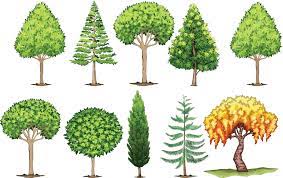
The 57 Different Types of Trees (with Custom Graphics)
#1. Arborvitae (Thuja occidentalis )
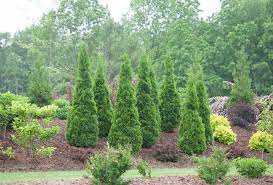
Arborvitae is a coniferous evergreen tree that belongs to the cypress family and is primarily ornamental. Other names include eastern white cedar, swamp cedar, American arborvitae, eastern arborvitae, and northern white cedar.
This is a small to medium tree that grows 40 to 60 feet, although some can get up to 125 feet tall with a trunk diameter of three to six feet. It has a growth rate of eight to twelve inches a year until they’re 15′ tall, then growth slows.
These trees have red-brown bark that peels in long narrow strips. The leaves are yellow to green scaly needles that grow in flat sprays ⅛” to 3/16″ long. They form a conical or pyramidal shape.
They produce slender yellow-green seed cones ⅜” to 9/16″ long that darken to brown. Each cone holds eight seeds.
Origins
Arborvitae trees are native to North America. They do best in zones 2 through 7, including eastern Canada up to the Arctic treeline and throughout the northern US.
Some populations span further south, such as Massachusetts, Illinois, Ohio, or into the Appalachian Mountains.
#2. Banyan Tree (Ficus benghalensis)
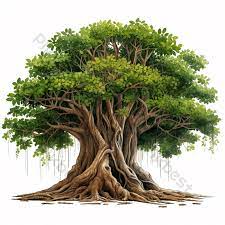
Banyan Trees are the national tree of India and the largest tree in the world. These trees can live hundreds of years and can take up acres of land.
They start their life as a small seed that starts to grow once it lands on a suitable plant host. Over time, it suffocates the host tree and develops large reddish leaves that mature into a rich green color with a glossy look and a leathery feel.
The roots of Banyan trees grow into elaborate systems that resemble large separate tree trunks. One tree can have dozens of root offshoots that make the tree look like a complete forest.
When mature, this tree grows syconium – a large pitless fruit of the fig family. Many animals feed off these foods, spreading the seeds to new hosts that they quickly smother out.
Banyan trees classify as both deciduous and coniferous trees. They shed their leaves every fall, as most coniferous trees are apt to do. But the leaves do not change colors before shedding.
Origins
This tree species is native to subtropical and tropical climates, meaning it likes hot, humid weather. It was first discovered in India and is now seen in warm regions across the globe.
Common places where the banyan tree grows include:
- Central America
- South America
- Pakistan
- Taiwan
- China
- Nepal
- India
- Sri Lanka
This tree species can also flourish in tropical-like climates in the United States like Florida and Hawaii.
#3. Black Ash (Fraxinus nigra)
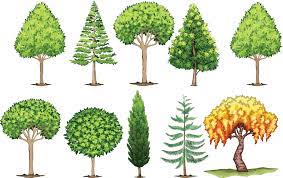
The Black Ash, or Fraxinus nigra, is a deciduous tree that thrives in waterlogged soil like swamps and flood plains.
These trees can reach 40 to 80 feet with a branch spread between 50 and 70 feet. The trunk is rarely more than two feet thick and doesn’t contain branches until high up.
This tree gets its name due to the bark’s dark gray color, which has a soft, corky texture and tends to develop fissures as it grows. It may appear flaky or scaly.
The leaves grow 8″ to 18″ in a pinnately compound opposite pattern. Each leaf has seven to thirteen stalkless ringlets that grow to three to five inches in length with fine-toothed margins.
The flowers of this tree have no petals or noticeable appearance. In the winter, this tree grows brown velvet buds. It produces samara fruit, which has a winged pod.
Origins
You can spot Black Ash trees throughout northeastern Canada and many states in the northeast of the US. This tree is native to Iowa, where it’s the most prominent. Other locations where you can find Black Ash include the Great Lake states and:
- Delaware
- Indiana
- North Dakota
- Iowa
- West Virginia
- Virginia
- Quebec, Canada
- Manitoba, Canada
- Newfoundland, Canada
#4. White Ash (Fraxinus Americana)
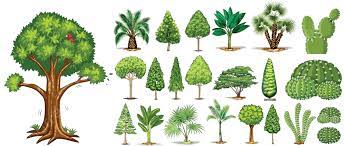
White Ash is a relative to Black Ash. However, they differ in leave color and growth location. These trees flourish in mesophytic hardwood areas near sugar maples.
White Ash trees, also called American Ash, can grow up to 50 to 80 feet with 40 feet to 50 feet branch span and a trunk width of two to three feet.
The bark has a yellow-brown to light gray color with furrows that create pointed ridges.
The compound leaves of White Ash have a metallic blue or gray color on the bottom. In the fall, they turn vibrant shades of yellow, purple, and red. These leaves grow 8″ to 15″ in length and have 5 to 9 leaflets that turn dark green.
This tree also produces 1″ to 2″ long samaras, a fruit with canoe-paddle shaped wings on each side. When these fruits fall from the tree, they create a neat visual as they seem to float.
Origins
White Ash trees are a native of North America. They grow throughout Nova Scotia, Canada down through the United States, including the states:
- Colorado
- Minnesota
- Florida
- North Carolina
- Texas
- Hawaii
- Wyoming
#5. Neem Tree (Azadirachta indica)
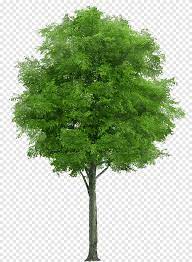
Neem trees classify as both deciduous and coniferous. Common names include Indian Lilac, nim, margosa, or nimtrees. It’s a type of mahogany belonging to the Meliaceae family.
This tree type stays green year-long, although severe drought can cause a loss of leaves. Neem trees are tropical or subtropical species that need temperatures around 80℉ but never below 39℉.
Although drought resistant, these trees still need 800ml in annual rainfall to thrive. These trees can grow between 49 to 98 feet in height.
Neem trees have compound leaves with toothed leaflets. They produce small, white bisexual flowers with a pleasing fragrance and a yellow-green drupe fruit, which has a sweet pulp.
Origins
Neem trees do well in warm, humid areas, so they thrive in many places in South Asia. It is native to India but now grows in many places. Locations where neem trees flourish include:
- India
- Bengal
- Iran
- Cambodia
- Myanmar
- Laos
- Vietnam
- Thailand
- Caribbean
You can also find these trees in some parts of Africa and Central and South America.
#6. Bigtooth Aspen (Populus grandidentata)
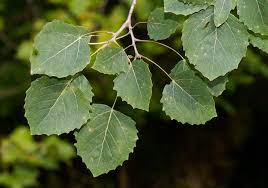
Bigtooth aspens have many names, including Canadian poplar, large-tooth aspen, long-tooth aspen, or American aspen.
These deciduous trees can grow anywhere from 50 to 75 feet, with a diameter of 8″ to 10″. They have a lifespan of 50 to 100 years.
The most notable trait of bigfoot aspens is the uniquely shaped leaves. These leaves have sharp ridges along the ends that give this tree its name. When the tree is young, the leaves along the lower surface will be cotton-white. In the fall, the leaves turn golden-yellow.
These trees’ bark is thin and smooth with an olive green color that turns white, thickens, and develops grooves with age.
The wood from Bigtooth aspen has straight grains and a fine texture, making it ideal for ladders, log homes, chopsticks, and pallets.
Origins
Bigtooth aspens originated in eastern North America and are found in many states in the US, including:
- Tennessee
- Connecticut
- Washington, DC.
- Delaware
- Kentucky
- Indiana
- Kentucky
- Maryland
- Illinois
- Michigan
- Maine
- North Carolina
- North Dakota
- Montana
- New Hampshire
- Rhode Island
- West Virginia
- Wisconsin
- New Jersey
- New York
- Pennsylvania
- Ohio
These trees also grow in Canada, including British Columbia, Quebec, Ontario, Manitoba, Nova Scotia, New Brunswick, and Prince Edward Island.
#7. Quaking Aspen (Populus tremuloides)
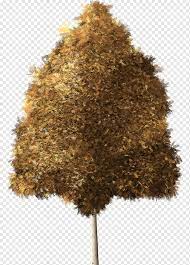
Quaking aspen trees have a high tolerance for cold weather. They grow up to 130 feet tall with a trunk diameter of 3 feet.
These deciduous trees are also known as trembling aspen, American aspen, trembling poplar, mountain or golden aspen, popple, and white poplar.
These trees have lightish green-gray colored smooth bark that becomes rough with porous tissue – lenticels – as the tree ages. They usually live to be 150 years old, although some can last longer than 200 years.
The glossy green leaves are round and smooth with toothed ridges on the edges. During the change of seasons, these leaves may turn golden or yellow. They rarely become red.
Quaking aspens have softwood that is light-weight, making it a good choice for matches and lumber. It’s also a popular component in the paper and pulp industries.
Origins
Quaking aspen trees are abundant in some of the coldest parts of Europe and Asia. These trees prefer high altitude and need plentiful supplies of sunlight and water.
Locations where you can find quaking aspens include:
- Iceland
- Scandinavia
- Spain
- British Isles
- Turkey
- Russia
- Japan
- North Korea
These trees are also a common sight in North America, including Canada, central Mexico, and the US. It is Utah’s state tree and makes up most aspen parkland biome in Canada and northwest Minnesota.
These trees grow at higher elevations of 5,000 to 12,000. They are in the highest numbers in Colorado and Utah but also seen in other western states.
#8. Eastern Cottonwood (Populus deltoides)
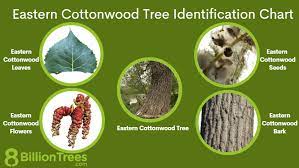
Eastern cottonwood trees are a deciduous species known for their foliage. This species is a relative of aspen trees and is among the fastest-growing and largest trees. Other names include the necklace poplar.
These trees can reach 56 to 195 feet, although some in history has grown to 100 feet. Their branch spread can span up to 113 feet, making them ideal for shade trees.
They have a growth rate of three feet a year and can live up to 150 years (depending on the species).
Cottonwood bark is smooth and silver-white during youth. Mature trees will have thick gray bark with deep fissures, which help protect the tree from fire and drought.
The leaves of cottonwood trees are large, dark glossy green, and have a triangular shape, a toothed edge, and a pointed tip. They grow alternate on flat stems that cause the leaves to dangle and clatter when the wind blows. In fall, the leaves turn yellow.
Cottonwoods get their name due to the seed pods, which are small fuzzy catkins that produce yellow (female) or red (male) flowers.
In the summer, these pods produce white fluff, which floats through the air. For many people, including this poor writer, this tree is a major pain in the A(llergies)!
Origins
Cottonwood trees are a native North American species found on numerous continents, including North America, Europe, and some areas in Asia.
In America, these trees grow across the country, including the central, eastern, and southwestern states. They also grow in southern Canada along the east coast and in the northeastern parts of Mexico.
#9. Mahogany (Swietenia mahagoni)
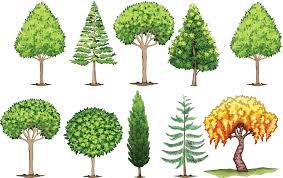
Mahogany trees have many names, including Cuban mahogany, small-leaved, West-Indian mahogany, and American mahogany.
Mahogany trees classify as both deciduous and coniferous as they shed half their leaves in the cold months. When the foliage comes back in the spring, it will start with a pinkish-red color before turning light green and darkening with age.
This is a medium-sized tree that grows 98 to 115 feet tall with a 3 to 5-foot trunk. The branches can stretch 50 feet wide in a round, symmetrical spread.
It produces pinnate 4″ to 9″ leaves. Each leaf has four to eight shiny green 2″ leaflets with a lance shape.
The bark of young mahogany trees is gray and smooth but darkens and furrows as it ages. The darker the color, the older, and denser the wood.
These trees produce simple, unattractive flowers and fruits – silver oval capsules 3″ to 5″ long containing winged seeds.
Origins
Cuban mahogany is a species native to the Caribbean and southern Florida. This tree grows in the Bahamas, Jamaica, Cuba, and Hispaniola.
It also grows in Puerto Rico and the Virgin Islands due to importation over 250 years ago. Florida has this species on their “threatened” plant list, the Preservation of Native Flora of Florida Act. It’s also a protected wood in other locations.
#10. Basswood (Tilia americana)
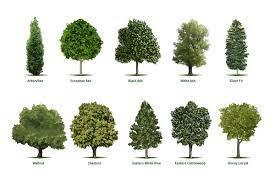
Basswood trees, otherwise known as American Linden, American basswood, honey tree, or bee tree, are native to North America.
These trees can tower between 75 and 130 feet tall. When in full bloom, the branches create an oval canopy atop a straight trunk.
These trees produce aromatic yellow blooms that attract bees, which they use to make honey. They can grow between 50 and 80 feet tall. The crown of these trees can spread 35 to 50 feet.
The leaves can grow three to six inches long in an alternate pattern with a heart shape and an unequal base. The ridges are coarsely toothed. They turn light yellow or brown in the fall.
Dark red buds with a blunt point and light brown or gray twigs are other signature features of this tree. Younger trees have light or silvery gray bark. It darkens to dark gray or black with long medium furrows as they age.
Basswood grows a unique fruit, shaped like an open cluster of hard nuts that grow out of a narrow, elliptical wing.
Origins
The American basswood tree is native to Iowa. It’s now spread around southeastern Canada and most of the eastern US. You can spot these trees in every county in Iowa. Other states in the United States where basswood grows are:
- Western parts of North Carolina
- New England
- New Jersey
- Tennessee
- North Dakota
- Northern areas in Arkansas
- Nebraska
- South Dakota
- Kansas
- Northeastern Oklahoma
It’s also in Canada, such as New Brunswick, Quebec, Ontario, and Manitoba’s southeastern corner.
#11. American Beech (Fagus grandifolia)
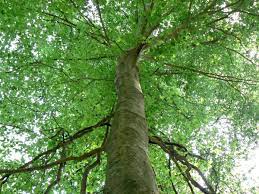
American Beech trees are deciduous slow-growing trees that do best in moist, well-drained acidic soil. These trees can grow from 65 to 114 feet tall, growing 12″ to 24″ a year. They can live two to three hundred years or more.
These trees are both decorative and ornamental, making great shade trees with a 40-foot canopy spread. Other names include White Beech, Ridge Beech, Beechnut Tree, and Red Beech.
The alternate, ovate leaves grow 3″ to 6″ in length and have sharp teeth on the edges. They have a dark green glossy color with prominent veins. The color changes to golden bronze in autumn. These leaves stay on the branches, even in winter.
Beech trees produce edible beechnuts, which are ½” to 1″ hard brown nuts with a three-sided triangular shape. They have low growing branches, a massive trunk with smooth silver-gray bark, and yellow-green flowers.
Origins
American beech trees are native to Chicago, Illinois, making them a North American tree species. They also grew native in Texas, Florida, Massachusetts, Illinois, Indiana, Montana, and Ohio.
This species does well in moist or wet lowlands. It grows in some parts of Canada like New Brunswick, Nova Scotia, Prince Edward Island, Quebec, and Ontario.
It grows in multiple states in the US, especially in the southern states like Tennessee, Texas, Florida, Georgia, Arkansas, Kentucky, Mississippi, and Louisiana. Other states include:
- Alaska
- Connecticut
- Washington DC
- Delaware
- Illinois
- Massachusetts
- Indiana
- Maryland
- Montana
- Michigan
- Minnesota
- New Hampshire
- North Carolina
- New Jersey
- Ohio
- Oklahoma
- Pennsylvania
- Rhode Island
- South Carolina
#12. Tulip (Liriodendron tulipifera)

Tulip trees are deciduous and belong to the magnolia family. These giant trees can grow up to nearly 200 feet tall in their lifetime, making them one of the largest trees on our list.
Other names for the Tulip tree include Tulip Poplar, Tulip Magnolia, white poplar, whitewood, or Yellow Poplar, despite this tree not being part of the Poplar family.
This tree species produces 8″-10″ broad leaves with a unique four lobe design. In the spring, these trees blossom with 4″ to 6″ wide six-petalled flowers that can have green, yellow, or orange coloring and resembles Tulip flowers, hence the name.
During the fall, the Tulip tree leaves will turn a bright pale yellow then brown. Then they will fall from the tree.
When young, the Tulip tree will have a smooth gray bark with a greenish tint and long white lines. The bark will start to darken to a gray-brown with long vertical furrows around 15 years old.
Origins
The Tulip tree is native to eastern North America, initially growing in southern New York and Connecticut, southern Ontario, and northern Ohio.
Today, these trees grow in many locations, including Canada and the US. This species grows as far north as southern Ontario and southern Quebec.
In the US., you can find Tulip trees in many states, including Massachusetts, Rhode Island, and Illinois. It can also grow in most southern states like Louisiana, Kentucky, Tennessee, and Florida.
These trees thrive in the Southern Appalachian mountains but rarely grow wild west of the Mississippi River. But you may see a few used for ornamental purposes.
Early settlers of America shipped Tulip tree species to Great Britain in the mid-1600s (1688) to be planted at Fulham Palace. It’s now a common ornamental species used to decorate large gardens, streets, and parks.
#13. Black Birch (Betula lenta)
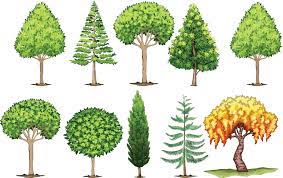
Black Birch trees are a medium-sized deciduous species found in North America. Other common names are cherry birch or sweet birch.
These trees can reach 115 feet in some areas. In the spring, the black birch sprouts green cones that darken to brown in late summer.
This tree’s leaves are 2″ to 4″ long with a dark, glossy green color. They also have single or double irregular serrations along the edge. In the fall, the leaves turn a vibrant golden yellow.
This species has hard, coarse-grained, heavy wood, with a dark brown color and yellow sapwood. When cut and exposed to air, the wood will darken to a color similar to mahogany.
Young trees will have reddish-brown or black bark with light lenticels. As the tree matures, the bark starts to darken to black and develop plates and scales.
The most common uses for Black birch trees are for fuel and furniture. The oil inside the twigs of a black birch can make medicine and flavorings, such as syrup.
Origins
The black birch is a native of eastern North America. The highest populations are in New York, Pennsylvania, Massachusetts, and Connecticut. They also grow in Canada, with many seen in southern Ontario.
Black Birch is a hardy tree that does well in various environments, including moderate droughts, winter conditions, and salt. They can grow from sea level up to 4,500 feet elevation, such as the considerable growth found in the Appalachian mountains’ southern part.
#14. Gray Birch (Betula populifolia)
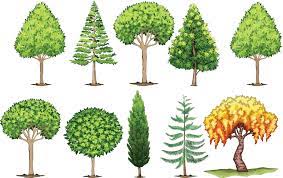
Otherwise known as white or poplar birch, Gray Birch trees are deciduous and native to North America. These trees can grow 65 to 98 feet tall with a 15″ diameter trunk.
They have 2″ to 3″ simple, alternate dark green, oval-shaped leaves with double serration and a long pointed leaf tip. These leaves turn yellow in fall. In the winter, they fall off.
Gray birch also produces 5″ to 8″ long catkins (erect – female; pendulous – male), which help this tree reproduce. In the fall, these fruits mature and contain multiple tiny winged seeds.
The bark of gray birch trees is smooth and thin with a reddish-brown color. The bark becomes chalky white as the tree ages, but it doesn’t peel the way black birch bark will.
The wood is a medium-hard with high oil content. Gray birch is used for furniture, spools, drum shells, plywood, and firewood.
Origins
Gray birch is a native tree to many Canadian provinces, including Ontario and Nova Scotia. It’s also common in the US, in states like Virginia, Pennsylvania, Indiana, New Jersey, and North Carolina.
#15. Paper Birch (Betula papyrifera)
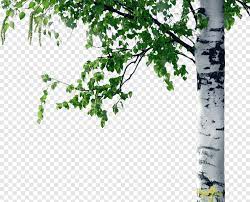
Paper birch, also referred to as white birch or canoe birch, is another common deciduous birch tree. This species is native to cold northern climates and does well in low temperatures.
These trees can grow 50 to 70 feet tall with a 35-foot wide trunk. They grow at a medium to fast growth rate of up to two feet a year and can survive up to 30 years in zones six and higher. For zones five and below, these trees can live over 100 years.
The bark of mature paper birch is easily identifiable due to the white peeling design with pink and black streaks. The inner bark is pink or salmon-colored. These trees may have reddish-brown bark with white lenticels until they mature around the age of five.
They produce clusters of dangling catkins in April to May, which are green or brown. If they are green and 1.5″ long, it’s a female flower. Male catkins are 2″ to 4″ long and brown.
Leaves of paper birch are 2″ to 4″ long, with a one-inch leaf stem. These double-toothed margined medium green leaves have an alternating leaf arrangement. They are smooth on the top with a veiny underside.
Origins
Paper birch trees are native to Alaska, Canada, and the northern states of the United States. These trees do best in zones 2-7 of the US, which are areas that receive the coldest winters.
Most provinces and territories in Canada, except for Nunavut, grow paper birch trees. You can sometimes see isolated growths in the Hudson Valley (New York, Pennsylvania, and Washington).
In high elevated mountains of New Mexico, Colorado, and North Carolina, paper birch can thrive. But it’s not seen further south.
#16. Yellow Birch (Betula alleghaniensis)
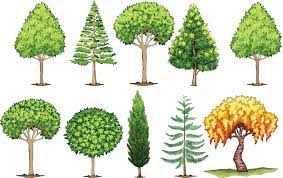
Yellow birch is another member of the birch family. Other names include swamp birch, gray birch, or silver birch.
These trees can reach heights of 60 to 75 feet with a 35 to 50-foot spread and a 2 to 3-foot wide trunk. Yellow birches grow at a medium rate of up to two feet a year.
These trees have bark that’s shiny yellow or gray-silver that peels and flakes in horizontal stripes. As the tree ages, the bark splits into curly strips and turns reddish-brown. Black streaks and dark lenticels are familiar sights in the tree bark.
Leaves of a yellow birch are oval, with a pointy tip and a cordate base, in an alternate pattern. These are 2″ to 5″ in length and half as wide, with a double serrated margin.
In spring, leaves have a dark green color that turns yellow in the fall. The color is darker on the top than on the pubescent veiny bottom.
Yellow birch trees produce male and female catkins. Males grow to be 2″ to 4″ that hang down and have a yellow, purple color. Female catkins are shorter (⅝” to 1 ⅛”), oval-shaped and grow up from spurs.
Origins
These trees are native to Northeast North America. They populate much of Canada, including New Brunswick, Nova Scotia, Newfoundland, and Anticosti Island. They also grow in southern Ontario and southeastern Manitoba.
In the US., these trees spread from Minnesota to northeast Iowa, northern Illinois, New Jersey, New England, Pennsylvania, and Ohio. They grow in the Appalachian Mountains, eastern Tennessee, and northeast Georgia.
#17. Butternut (Juglans cinerea)
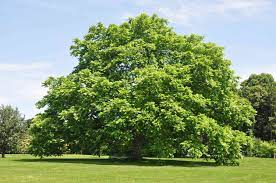
Butternut trees are deciduous trees that produce edible nuts. This tree belongs to the walnut family and is called the white walnut tree. This slow-growing tree can take one year to grow one foot.
These trees can grow to heights of 40 to 60 feet, although there are records of some trees growing over 100 feet tall. The bark of a butternut tree is gray and might be light. The trunk often grows crooked instead of straight.
They have an open crown with a 35 to 50-foot spread of compound leaves, which have a pleasing fragrance. These bright green leaves can grow to 15″ to 25″ in length with 11 to 19 serrated leaflets. In fall, the leaves change to yellow.
Although these trees produce small male and female flowers, they are not decorative. The flowers do not grow more than 3″ long with light coloring. Male flowers are pale green-yellow, while females are light yellow and contain the butternut fruit inside a husk.
The butternut is a 1 ½” to 2 ½” edible nut with a rich butter flavor. Typical uses are snacks, baking, or confections.
Origins
The butternut tree is a native species to the eastern US and southeast Canada, including southern Quebec and east New Brunswick.
Despite the origins, these trees have managed to travel from Minnesota as far into the south US as Georgia, Arkansas, and Alabama. They do best in zones 3-7.
#18. Black Walnut (Juglans nigra)
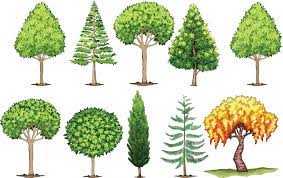
The black walnut tree is at the top of the most valuable hardwoods in North America. It’s also one of the rarest hardwoods. It belongs to the walnut family and is heavily desired for its rich, heavy grain.
These deciduous trees grow 98 to 131 feet with a 50 to 75-foot spread. Black walnuts have a medium growth rate of 13″ to 24″ a year.
These trees produce an edible nut that can be difficult to get due to the three layers. The other layer is a greenish fleshy husk. Below that is a thick, hard black shell. The inside of the shell is the kernel, a sweet oily nut.
The leaves of these trees are alternate pinnately compound that grow to be 12″ to 24.” Each leaf has fifteen to twenty-three 2″ to 5″ dark green leaflets with fine-toothed ridges.
Origins
This tree is native to North America. It grows from southern Ontario down into the US from South Dakota to Georgia, northern Florida, and central Texas.
It also grows in many places in Africa and some parts of Europe. These trees prefer riparian conditions near rivers and streams.
#19. Black Cherry (Prunus serotina)
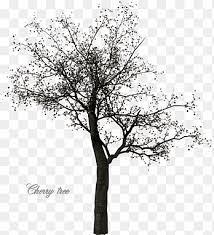
Black cherry trees, often mistaken for a shrub (it belongs to the rose family – Rosaceae), are a medium-sized deciduous tree. Other names are wild cherry, black cherry, rum cherry, wild black cherry, and mountain black cherry.
These trees have a fast growth rate of 24″ to 36″ a year. They can grow up to 50 to 80 feet tall, with a crown spread of 30 to 50 feet and a two-foot trunk diameter.
These trees have a reddish-brown bark with white incisions to help the tree breathe. Older mature trees will be darker and rougher with scales that have upturned edges. The inner wood has an attractive red-brown tone, making it a desired wood for furniture.
The leaves are an oval shape, with a glossy dark green top and rust-colored hairs along the mid-vein and base on the bottom. They have a pointed tip and curved teeth along the edges.
Black cherry trees produce a dark red (almost black) drupe – a fleshy fruit containing one seed in the middle. These fruits ripen from late August to the end of September. Drupes are smaller and more bitter than the cherries you find in stores.
Origins
Black Cherry trees are dominant in only one forest in the US – black cherry-maple forests. The largest growths are in northern West Virginia, western Pennsylvania, eastern Ohio, and western New York.
They are native to every county in Iowa, except Sioux and Lyon. It grows through southeastern Canada and the eastern US.
Some populations exist in eastern and central Texas and the mountains in the southwest US, Mexico, and Guatemala.
#20. Pin Cherry (Prunus pensylvanica)
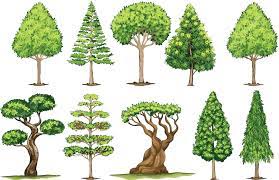
Pin cherries are a type of cherry tree that grows wild. Common names include Fire Cherries and Bird Cherries.
These trees can grow up to 30 feet tall with a straight narrow trunk and a rounded, flat crown. The trunk diameter can be between 4″ and 20.”
The bark is a smooth, shiny reddish-brown color with orange, white, or tan lenticels. As the tree ages, the bark may peel like thin pieces of paper.
Leaves of the pin cherry tree have a lance or oblong stape with fine teeth along the edges. These leaves turn bright red and orange during the fall. They have an alternate pattern and grow 1 1/2 “to 3” in length.
Pin cherry trees produce small white flowers in the spring. These grow in clumps with five to seven five-petaled flowers.
The fruit ripens in late summer to early fall. These ¼” cherries have a bright red color with a sour taste and a large stone in the middle. They grow on long stems in clusters.
Origins
Pin cherries are a common species throughout most of Canada, including Newfoundland, British Columbia, the southern Northwest Territories, and the southern Rocky Mountains and Colorado.
#21. American Chestnut (Castanea dentata)
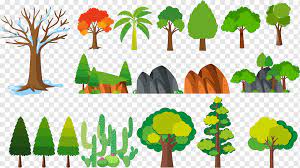
The American Chestnut tree is a deciduous species that belong to the beech family. This hardwood is an endangered species in Canada and the US.
These trees once grew up to 98 feet tall with a 10-foot diameter. But due to a fatal blight disease in 1904, the majority of these trees died. What remains are newer growths that haven’t reached their full height potential. It is rare to almost impossible to find these trees growing in the wild.
These trees produce large leaves with wide saw teeth along the edges. These leaves can grow to be 5 ½” to 8″ in length and 3″ to 4″ wide.
As a monoecious species, chestnut trees produce small, light green (almost white) flowers (males) and 6″ to 8″ catkins, which houses the female parts at the base.
American chestnut trees also produce nuts, which grow in a cluster of three inside a green spiny burr, covered with tan velvet.
Origins
There used to be an estimated four billion American chestnut trees spread along the east coast of America. These giant trees stretched from Maine all the way south to Florida and Mississippi.
Now, there are less than 100 remaining large American chestnut trees. You can see some groves growing in Sherwood, Oregon, and Revelstoke, British Columbia. But most new growths will not survive more than ten years.
#22. Cucumber (Magnolia acuminata)
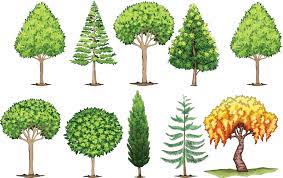
The Cucumber tree is a member of the magnolia species and the most common of the eight variations. Other names are blue magnolia or cucumber magnolia.
These medium-sized deciduous trees grow up to 50 to 80 feet with a short straight trunk with a 2′ to 3′ diameter and a forty foot round spread. The growth rate is medium to fast, meaning 13″ to 25″ a year.
Cucumber magnolia trees have smooth bark when they are young that furrows with age. The color can be reddish or grayish brown.
The leaves are alternate oval or oblong with a length of 6″ to 10″ and a width of 6 to 12 cm. These leaves have smooth margins and a downy underside. They have an acuminate tip and a dark green color. In fall, these change to yellow and brown.
Flowers produced by this species of Magnolia are not ornamental. They are small in size with a yellow-green color that blooms between April and June.
These trees get their name from the small green unripe fruit, which resembles a little cucumber. As the fruit ripens, it turns a dark red to orange color. Each fruit contains ten to sixty bright red seeds.
Origins
The cucumber magnolia tree is native to the Appalachian belt, from New York, western Pennsylvania, and the Cumberland and Allegheny Plateaus. It is the only magnolia species native in Canada.
Numerous outlying populations occur throughout most of the southeast US, including Georgia, Florida, Louisiana, Illinois, Indiana, Missouri, Ohio, and Oklahoma. There are smaller populations found in the southern part of Ontario.
But the cucumber tree is on the endangered species list in Canada and protected by the Canadian Species at Risk Act.
#23. American Elm (Ulmus americana)
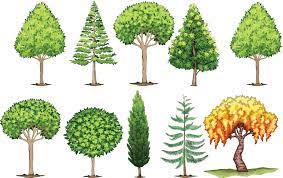
American Elm trees in the wild can grow up to 100 feet or more, but cultivated trees usually stop growing at 60 to 80 feet tall.
These trees have a thick columnar truck that splits into large branches and smaller branches that arch into a vase shape. The spread of an American Elm can span
The bark of these trees is a dark brown-gray color with deep ridges. When these trees are young, the bark will look scaly.
They have ovate-shaped alternating leaves with a double serration and straight veins. These are three to six inches long, with a dark green color that changes to brown or yellow in fall.
These trees produce tiny red flowers (petalless) on pendulous stalks that bloom in late winter before the leaves’ emergence.
The fruit from these trees is small, flat, and round, with a paper texture and a notch on the apex. These samaras hold a single green or yellow seed.
#24. English Elm (Ulmus minor ‘Atinia’)
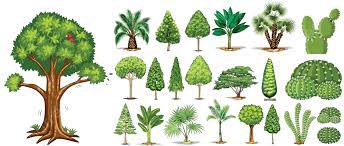
The English Elm, also known as field elm, common elm, the horse may, and Atinian elm was once the most common elm in central southern England. It was also the quickest and largest growing deciduous tree growing in Europe.
These trees reach 98 to 130 feet tall with a trunk width of 50 feet. They have a quick growth rate of 36″ or more each year and a life expectancy of more than 150 years.
English Elms’ bark is dark with a grayish-brown coloring, a rough texture, and deep fissures. In older trees, the furrows create a block pattern. Suckers grow on the base, and fine hair grows on the twigs.
The leaves are 3″ to 6″ long in an alternate, ovate shape with a dark green color that changes to yellow, orange, or gold in the fall. These leaves have sharp edges, a rough top side and a pubescent underside, and an oblique base. They form a canopy spread of 50 feet.
These trees produce ½” to 1 ½” fruit – greenish-yellow rounded, winged samaras with a notch at the top in the spring.
As a monoecious tree, the English Elm produces small, dark pink to red flowers that hang down in tassels. These flowers contain both the male and female parts and bloom from February to March.
Origins
These trees are native to southern and western Europe, Britain, Asia Minor, and Iran. It can also grow in the Baltic islands (Gotland and Öland), although not naturally. They do best in USDA zones 5-8.
At one time, these trees grew abundantly in England. But a disease called Dutch elm wiped out over 20 million trees in the 1960s-1970s.
#25. Slippery Elm (Ulmus rubra)
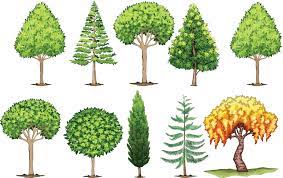
Slippery Elm trees are medium-sized deciduous species also referred to as red elm. They have a life expectancy of up to 200 years. The inner bark of these trees is red, sweet, and fibrous.
These trees can grow 39′ to 62 feet, sometimes topping 98 feet tall with a trunk diameter of two to three feet. They can spread 49 feet and grow at a medium rate of two feet or less a year.
The bark of a Slippery Elm is brownish gray with deep furrows and layers of outer bark with a reddish-brown hue. The ridges of the bark lift higher on one edge than the other, which is a notable difference to American elm.
These trees have 5″ to 7″ oval leaves with an alternate pattern. These leaves have an oblique base, a double serrated margin, and a dark color on top with a pale color and white hairs on the bottom. They feel rough to the touch.
Slippery Elm trees produce ½” to ¾” flat-winged fruits that contain a single seed. These form in clusters in late May to early June. In the winter, ¼” dark brown buds grow long, rust-colored hairs.
Origins
The Slippery Elm is native to North Carolina and eastern North America. You can find these trees across the US, including North Dakota, Pennsylvania, Maine, Florida, and Texas. It also grows in southern Quebec.
#26. Balsam fir (Abies balsamea)
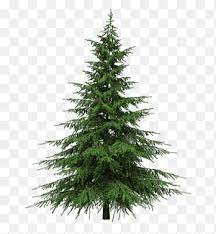
Balsam fir trees are a small to medium-size evergreen species that belongs to the pine family. Other names are Canada Balsam, Eastern Fir, Bracted Balsam Fir, and Canadian Balsam. It’s the provincial tree of New Brunswick, Canada.
These trees can grow to heights of 45 to 75 feet with a 20 to 25-foot symmetrical spire crown spread.
These trees produce ¾” long dark green flat needles in a spiral design. These needles grow on the branches individually rather than in bundles like Eastern White Pine trees. They are soft to the touch and have a pleasing aroma.
The bark of Balsam Fir trees is smooth, thin, and gray with resin blisters. As the tree ages, the bark breaks into brown scales.
These trees produce male and female cones that grow to 1 ½” to 3″ in length, with a purple to blueish brown color. These cones grow on the top branches and stand erect.
Origins
Balsam firs grow throughout northeastern America, including Canada and the US. You can see these trees from Labrador and Newfoundland to northern parts of Ontario and Quebec in Canada.
In the US, these trees grow from north Minnesota to Iowa, parts of Michigan and Wisconsin, New York, and Pennsylvania. They’re also a common sight in the New England States, including Connecticut.
#27. Hawthorn (Crataegus)
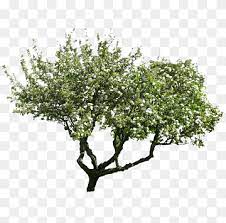
Hawthorn trees, also called quickthorn, thornapple, whitethorn, hawberry, or May-tree, is a small tree better classified as a shrub. It belongs to the Rosaceae family.
These shrubs have a height of 16 to 49 feet, trunk diameter of 8″ and a spread of 25 to 35 feet. Young trees have smooth gray bark that develops shallow fissures and ridges and darkens to brown with age.
Hawthorn trees produce clusters of 0.4″ white blooms in the late spring to early summer. They have a robust pleasing odor and produce berries that continue to grow through the winter.
The small pome berries start as green before riping to a dark red in the fall. Each berry contains one to three seeds that are not consumable due to containing cyanide, a type of poison harmful to humans.
They produce spirally arranged leaves with lobed or serrated margins. These grow on long shoots and in clusters of spur shoots. A signature feature of hawthorn bushes is sharp thorns that can grow up to 4.5″ long.
Origins
Hawthorn trees are native to North Africa, West Asia, and most of Europe and imported to North America and Australia. These trees do best in temperate areas of the Northern Hemisphere.
#28. Eastern Hemlock (Tsuga Canadensis)
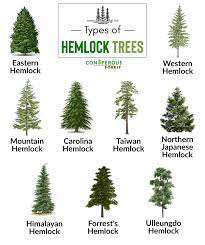
Eastern Hemlock – also called eastern hemlock-spruce and Canadian hemlock – is a coniferous tree that belongs to the pine family.
These trees grow to 50 to 70 feet with a 20 to 30 feet conical crown spread. Trunk diameters can be up to four feet. The tallest tree reached 102 feet.
These trees have a slow growth rate of less than 12″ a year and an astonishing lifespan of up to 400 years. It can take 250 to 300 years for a tree to reach maturity. The oldest tree lived to be 554 years old in Tionesta, Pennsylvania.
Eastern hemlocks have a straight monopodial trunk with a four-foot diameter, covered in smooth gray-brown bark when young. As these trees age, the bark darkens to a cinnamon brown and develops deep fissures and scales.
Eastern Hemlocks produce short (less than 1″ long), flat needles with blunt tips and slightly toothed margins. These leaves are shiny green to a dull yellowish-green on top and a silvery bottom. They keep their color year-round.
These trees start to produce female and male flowers around 15 years of age. From April to early June, the male flowers blossom in clusters of light-yellow flowers. The flowers develop scales and form a conelet.
Female flowers form into erect light green cones until pollinated; then, they begin to droop. The female cones turn brown and release seeds in fall.
Origins
The Eastern hemlock is native to the Appalachian and northeastern parts of North America. In Canada, these trees grow in Nova Scotia, New Brunswick, southern Ontario, and Quebec’s southern regions.
These trees can be seen as far south as Alabama or northern Georgia and as far west as Minnesota in the US. Outlying populations also exist in southern Michigan, southern Indiana, and western Ohio. You can also find random growths in the middle Atlantic states.
#29. Bitternut Hickory (Carya cordiformis)
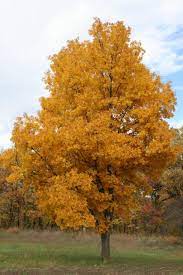
Bitternut Hickory, also called swamp hickory or bitternut, is a type of pecan hickory that can live up to 200 years.
These trees grow up to 115 feet tall, although some may tower up to 154 feet. They have a three-foot diameter trunk and a spread of 40 to 50 feet at maturity.
These trees have light gray smooth bark with narrow ridges and yellow tint when young. As the tree matures, the bark turns scaly and granite gray with coarse ridges.
Bitternut hickories produce a 1″ medium-sized nut. This fruit has a thin, green husk covering a thin, brittle cream-colored shell and a bitter red kernel.
Leaves are an alternate pattern, with a pinnately compound design 6″ 6o 12″ long. Each leaf has seven to nine yellow-green elliptical leaflets with toothed edges. These leaflets have a smooth top and a fuzzy pale underside.
These trees produce male and female flowers. Male flowers form in clusters of three hairy drooping catkins that grow 3″ to 4″ long. Female flowers grow as one or two small green flowers with spikes.
Origins
Bitternut hickory trees are native to North America, with some growth in Canada (southern Quebec and southern Ontario) and heavy populations in the eastern US.
These trees grow in Maine, Vermont, New Hampshire, Michigan, Texas, Minnesota, Florida, and Georgia. The most common sights are through southern New England, Iowa, southern Michigan, and Kentucky.
#30. Pignut Hickory (Carya glabra)
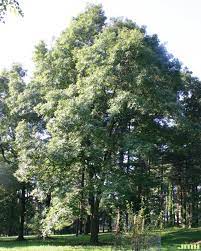
Pignut hickories go by many names, including coast pignut history, sweet pignut, swamp hickory, smoothbark hickory, and broom hickory. This tree is a relative of the black walnut and the pecan tree.
These trees grow 80 to 135 feet with a two-foot diameter trunk and a spread of 25 to 35 feet. They have a lifespan of 200 years with a growth rate of two feet a year.
Pignut hickory leaves are alternate pinnately compound with five to seven inch long lance-shaped leaflets. These leaves have a dark yellow-green top with a pale glabrous underside. They have a rounded leaf base, a long pointed apex, and serrated edges. In fall, they turn golden yellow.
These trees have gray furrowed bark with narrow, interlacing ridges that grow scaly with maturity. They produce male flowers – three yellow-green hanging catkins on 2″ to 3″ stalks. Female flowers grow in clusters as 2″ to 5″ spikes.
The fruit from a Pignut Hickory grows to 1 ¼” long in a pear-shape. These nuts have a thin green unridged husk and, when opened, resembles a pig’s nose. The husk turns brown to black when ripe around September to October. The small seed has a sweet taste.
Origins
Pignut hickory trees are native to North America. These trees grow from Ontario, Canada, into Maine, south to central Florida, Alabama, Michigan, and Mississippi.
They are in most eastern US states, including Massachuttes, West Virginia, Kentucky, and North Carolina. The highest concentrations are in the lower Ohio River Basin, Ohio valley hill country, the Appalachian forests, and the Cumberland Mountains in Tennessee.
#31. Shagbark Hickory (Carya ovata)
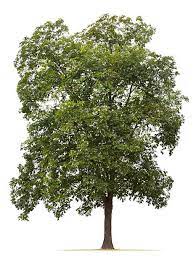
Shagbark hickory trees are a common deciduous tree that belongs to the hickory family.
These trees grow 60 to 100 feet tall with an oval-shaped canopy spread of 40 feet. These trees grow at a slow rate of less than 12″ a year and have a lifespan of 200 to 300 years.
Young trees have smooth bark, while mature trees grow shaggy, light gray bark that curls up once they have a four to eight-foot diameter. Their bark is what gave these trees their name.
These trees have alternate compound leaves that grow up to 22″ in length. Each leaf has five to nine leaflets with finely toothed edges. The leaves have a yellow-green color that turns golden yellow in fall and shed.
The shagbark hickory nuts are round and grow to be 2″ due to the thick ridged husks, which resemble tiny green pumpkins. The husk darkens to brown and splits apart when ripe. The nut inside is edible with a yummy sweet flavor.
These trees produce hanging green male flower catkins on long stalks, and female flowers are short spikes that form into the fruit.
Origins
The Shagbark hickory is native to the Eastern United States and Kansas. But this tree rarely grows further than northern New England or Canada, except for an isolated growth in Lavant Township, Canada. It is almost non-existent in the southeast, Gulf coast plains, and lower Mississippi Delta.
#32. American Hophornbeam (Ostrya virginiana)
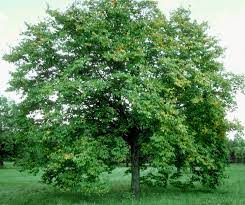
The American Hophornbeam is a small understory deciduous tree with a slow growth rate. Other names include Eastern hop hornbeam, hop hornbeam, leverwood, ironwood hornbeam tree, and ironwood. It belongs to the birch family.
These trees only grow up to 20 to 35 feet tall, although some can reach 59 feet tall. They have an 8″ to 20″ diameter trunk and a pyramidal or rounded spread of 20 to 30 feet.
When young, the bark is a smooth reddish-brown with multiple horizontal lenticels. As the tree matures, the bark develops a gray-brown color and small shaggy plates and loose scales that peel and flake.
The 2″ to 5″ leaves are a simple ovoid-acute shape in an alternate pattern with double toothed edges and fuzzy stems. The tops are dark green, while the underside is paler and has sparse to moderate fuzz. In fall, the leaves turn from dark green to lemon yellow, red, or yellowish-brown.
These trees produce male and female flowers. The yellow-green male catkins grow ¾” to 2″ long in groups of three throughout winter. The female (pistillate), appearing in April, are 5/16″ to 19/32″ long spiky catkins with 10 to 30 flowers.
Origins
This tree is native to North America, growing as far north as Cape Breton, Ontario, Nova Scotia, and Manitoba down to Minnesota, Wyoming, and further south to Florida and Texas. Some growths exist in Central America and Mexico as well.
#33. American Hornbeam (Carpinus caroliniana)
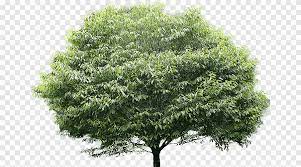
The American Hornbeam is another small understory hardwood tree, also called musclewood or blue-beech. They have a lifespan of 50 to 150 years.
These trees grow up to 20 to 50 feet with a slow growth rate of less than a foot a year. They have a canopy spread potential of 20 to 30 feet with a crooked or fluted trunk.
The bark of American hornbeams is smooth with a grey-green color. As the tree ages, the bark develops shallow fissures and furrows and may turn dark gray.
The simple, alternate 2 ½” to 5″ leaves start growing as a purple-reddish color before they darken to green. In the fall, the color changes to yellow and orange-red. Features include a pointed tip and double serrated margins.
In spring, the male and female catkins bloom at the same time as the leaves. The appearance is unadorned and unnoticeable. These trees also produce clusters of involucres, each containing a single oval nut inside a three-lobed husk.
Origins
The American Hornbeam is native to eastern North America, including Canada and the US. In Canada, this tree grows in southeast Ontario and southwest Quebec. In the US, it grows in Maine, Minnesota, down to northern Florida and eastern Texas.
#34. American Larch (Larix laricina)

American Larches have many names, such as the tamarack, eastern larch, hackmatack, black larch, and red larch. This small to medium tree is both deciduous and coniferous and belongs to the pine family.
These trees can grow 33 to 66 feet tall with a spread of 50 feet and a 24″ trunk diameter. They have a fast growth rate of two feet or more per year with a life expectancy of 200 to 300 years.
They have tight, flaky pink bark that appears reddish underneath.
They also produce clusters of 10 to 20 ¾” to 1 ¼” short spiral needle leaves that start as a light greenish-blue color. In the fall, they turn bright yellow and fall off the limbs.
These trees also have ⅜” to ⅞” bright red cones covered with 12-35 seed scales. Once mature, the cone turns brown and opens to release the seeds.
Origins
This species is native to Canada, ranging from Inuvik and eastern Yukon, Newfoundland, and the Northwest Territories.
Some American larches also grow in the northeastern US from Minnesota to West Virginia, with an isolated population growing in central Alaska.
#35. European Larch (Larix decidua)
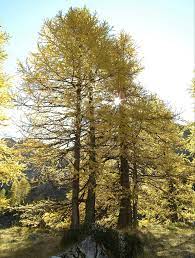
European Larches, or common larch, are both coniferous and deciduous and a pine family member.
These trees can grow from 70 to 100 feet in height with a trunk diameter of two feet. The conical crown can produce a 20 to 30-foot canopy spread. They have a medium growth rate of 12″ to 24″ each year and a lifespan of 200 years, although some can live up to 1,000 years.
The bark of young trees will be smooth and a greenish brown-gray color. As the tree matures, it grows deep furrows and scaly ridges; the color darks to a pinkish brown.
The common larch produces flat, soft ¾” to 1 ¼” slender needles that form in clusters. These needles are bright green in the spring and turn a dull yellow in fall before falling off.
They also produce ½” to ¾” spherical cones with a red or green color. As they mature, the color turns to brown. The cones open in fall to release small, winged seeds.
Origins
These trees are native to south and eastern Europe in zones 2-6. They are predominant in the Alps, Pyrennes, and the Carpathian Mountains. Some populations grow in southern Lithuania and northern Poland and naturalized in Scandinavia.
European larch can also grow in southern Canada and many states in the northeast US, including New Hampshire, Connecticut, Vermont, Maine, Michigan, Rhode Island, and New York.
#36. Black Locust (Robinia pseudoacacia)
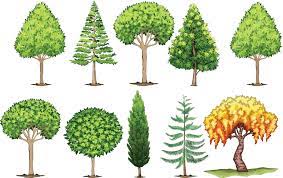
The black locust, or false acacia, is a medium deciduous hardwood tree that belongs to the legume family. Its relatives are the bean and pea plants. Other names are yellow locust, white locust, green, locust, or post locust. This tree is an invasive species in some areas.
Black locust trees can grow anywhere from 40 to 100 feet tall with a trunk diameter of two to four feet wide and a canopy spread of 20 to 35 feet. They have a lifespan of fewer than 100 years and a fast growth rate of two feet or more each year.
When young, these trees have smooth brown bark. The bark starts to thicken and develop furrows and scales as it ages to form diamond patterns. The color turns to reddish black or gray. There may be orange or red highlights in the grooves.
The dark bluish-green leaves are alternate pinnately compound and grow 6″ to 14″ long on a central 8″ to 12″ stalk. Each leaf has 7 to 19 one to two-inch leaflets. In the fall, these leaves turn clear pale yellow colors.
These trees produce attractive clusters of drooping white 4″ to 8″ flowers, which have a pleasant fragrance from May to June. These flowers contain both male and female organs.
Black locust trees also produce a flat, smooth legume fruit that’s 2″ to 4″ long and contains four to eight dark orangish-brown seeds.
Origins
This tree is a native of the eastern US. It grows in all of the lower 48 states, with the highest populations in the Appalachian Mountains (northern Georgia to Pennsylvania) and the Ouachita Mountains and Ozark Plateau (Missouri, Arkansas, Oklahoma).
These trees were also transported to other countries, including Australia, India, China, Pakistan, Europe, Canada, south and north Africa, New Zealand, the southern parts of South America, and some places in Asia.
#37. Honey Locust (Gleditsia triacanthos)
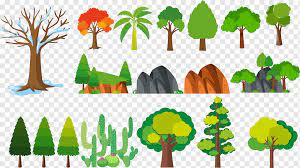
The honey locust – also called the thorny honeylocust or thorny locust – is another deciduous tree.
These trees have gray-brown, bronze, or red-brown bark, depending on the age. The bark starts as smooth with horizontal lenticels, which turn into narrow curling plates once the tree matures. You’ll also notice clusters of thorny branches along the trunk.
They produce elliptical or ovate shaped, pinnately, or bipinnately alternate compound leaves with a length of 5″ to 8.” Pinnate leaves have 15 to 30 leaflets, while bipinnately leaves will have only four to seven leaflets less than 1 ½” long. Leaves have a dark green color that turns to golden yellow in fall.
Honey locusts blossom with hanging clusters of narrow 2″ to 3″ small greenish-yellow flowers. These flowers are not showy but have a delightful aroma.
They also produce a flat fruit pod that may be leather or somewhat hairy with thick walls and tapered ends. They vary from green to a reddish or purple-brownish color and can also be dark brown or black. The size ranges from 6″ to 18″ and can contain 6 to 20 seeds and a sweet brown or light green pulp.
Origins
The honey locust is native to central North America, from Pennsylvania to Nebraska, east to west, and north to south from southern Minnesota down to south Louisiana. The highest numbers are in Indiana and southern Illinois.
#38. Red Maple (Acer rubrum)
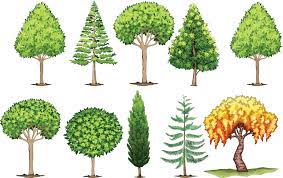
Red Maple trees – also called soft, water, or swamp maple – are a medium-sized fast-growing tree that’s one of the most common deciduous North America species.
These trees can grow to heights of 40 to 90 feet with a one to two-foot trunk diameter. These trees produce a narrow oblong or rounded spread up to 40 feet. They have a growth rate of 13″ to 24″ a year and a lifespan of 80 to 100. Some may live up to 200 years.
Young trees have thin, smooth, light gray bark that darkens to dark gray with rough shallow fissures as the tree ages. The tree trunk is absent of tree limbs until midway up.
They produce simple, opposite 2″ to 4″ leaves with three-pointed lobes, shallow sinuses, and coarse, irregular serration edges. The leaves are light green on top in spring, with a paler glabrous underside with red or red-green petioles. Come autumn, they turn brilliant shades of yellow, red, and orange.
From March to April, these trees bloom with clusters of red flowers that form into samara fruit from May to June. The ⅝” to 1″ winged fruit can be red or green colored and turning tan at maturity from April to June.
Origins
The red maple tree is native to central and eastern North America and is the most abundant native tree on the continent’s east half.
These trees can grow in Canada and the US, from southeastern Manitoba, Ontario, Lake of the Woods, and eastern Newfoundland. In the US, these grow from Minnesota down to Florida and east Texas.
#39. Silver Maple (Acer saccharinum)
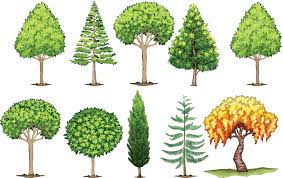
Silver Maple trees – soft maple, swamp maple, creek maple, large maple, Silverleaf maple, white maple, water maple – are a deciduous maple species.
These trees can grow to heights of 49 to 82 feet, with some exceptions of 115 feet. They spread 36 to 49 feet and a fast growth rate of more than two feet a year. By the time a sapling is ten years old, they stand around 26 feet tall. They have a lifespan of 130 years or more.
The bark of young trunks is smooth and a silvery gray. As the tree matures, the bark turns to a darker gray with a rougher, shaggy texture.
These trees have 3″ to 6″ leaves that have five lobes separated by narrow sinus cavities. These leaves have a green colored top side with a silvery shaded bottom. In the fall, they change to pale yellow.
In early spring, clusters of yellow, silver, and red flowers bloom before leaf growth. By late spring, these flowers turn into pairs of winged samara fruits that grow over 3″ long, making them the largest maple seed.
Origins
The Silver Maple tree is native to the central and eastern United States and some southeastern parts of Canada, including Ontario, southern Quebec, and New Brunswick.
It’s become one of the most popular trees seen in the US, growing in central Maine, northern Michigan, southeastern South Dakota, eastern Nebraska, Minnesota, Oklahoma, Kansas, Mississippi, Arkansas, Louisiana, Alabama, and Georgia.
However, it is not native to Florida or the Atlantic Coast. It also doesn’t grow at high elevations in the Appalachian mountains.
#40. Sugar Maple (Acer saccharum)
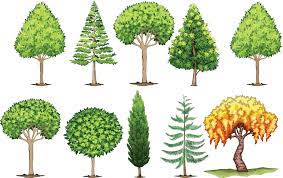
The Sugar Maple, also called birds-eye maple, rock maple, sugar tree, curly maple, sweet maple, and hard maple, is a flowering plant that belongs to the maple family.
These trees grow to heights of 80 to 115 feet with a crown spread of 40 to 50 feet and a trunk diameter of three feet. They have a 12″ to 24″ yearly growth rate and a life expectancy of 300 to 400 years.
The bark of young sugar maples is smooth gray-brown to light gray. As the tree matures, the bark darkens and develops deep furrows.
They develop long-petioled opposite blade leaves that grow up to 8″ long and wide with five lobes. In fall, these leaves become bright yellow, orange, or fluorescent red-orange. But they color unevenly, with some trees showing all the different shades at once while others change in certain areas.
These trees produce small greenish-yellow flowers in drooping clusters of 8 to 14 on long stalks. The flowers bloom into a pair of small samaras that fall to the ground in autumn.
Origins
The sugar maple is native to eastern Canada, including southern Ontario, Nova Scotia, south Quebec, southeastern Manitoba, and Lake of the Woods.
These trees are native to the northeast and the north-central US, from Maine to Minnesota, Missouri, Tennessee, and Virginia.
#41. Black Oak (Quercus velutina)
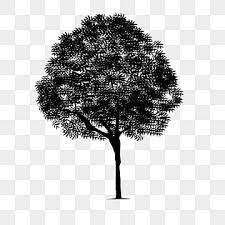
Black Oak trees are a medium-sized deciduous tree that belongs to the red oak family. Other names are quercitron, yellow oak, smoothbark oak, or yellowbark oak.
Black oaks can grow 60 to 150 feet in height with a straight trunk diameter of 24″ to 48″ and an open canopy spread of 85 feet. They have a growth rate of 24″ to 36″ a year with a lifespan of 100 to 200 years.
These trees have black, furrowed bark with deep, horizontal grooves that create a blocky pattern. The inner bark is yellow or orange. Gray patches adorn the limbs and twigs.
Leaves are alternate, simple with seven to nine deep incised lobes tipped with short, stiff hair. These leaves grow to 10″ long and 8″ wide with a dark green color on top and fine hairs on the underside.
Black oaks produce clusters of drooping yellow catkins (male flowers) 4″ to 6″ in length, and female flowers form in spiked clusters of one to four. The fruit of black oaks is a single or a bunch of two to five acorns.
Origins
The Black Oak tree is native to the midwest and eastern parts of the United States. These trees grow from the southwest parts of Maine, New York, Ontario, Iowa, Minnesota, Nebraska, central Oklahoma, eastern Texas, northwestern Florida, Georgia, and eastern Kansas.
#42. Chestnut Oak (Quercus Montana)
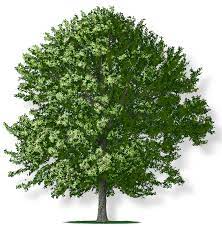
Chestnut oak is a member of the white oak family and is also called rock oak. These trees can grow to heights of 60 to 70 feet with a 45-foot symmetrical round crown.
They have a grayish-brown bark with massive ridges and scales. This tree has the thickest bark of all eastern North American oaks. The branches start as bronze-green, turn to reddish-brown, and finally darken to brown or dark gray.
They produce alternate 5″ to 9″ long broad obovate, lanceolate, wedge, or rounded leaves with 10 to 15 shallow rounded lobes on each margin. In spring and summer, they are a dark yellow-green color. By fall, they change to yellow, orange, and brown.
They also produce pale yellow, hairy male catkins 2″ to 3″ long and short, spiky female flowers that turn into a 1 ¼” long brown acorn with a sweet taste.
Origins
Chestnut oak trees are native to the eastern parts of the US. It is one of the most crucial ridgetop trees in the states from central Mississippi to southern Maine, including Tennessee, parts of Alabama, Georgia, and Kentucky. Outlying populations grow in south Michigan. It does best in zone 5A to 9A.
#43. Scarlet Oak (Quercus coccinea)
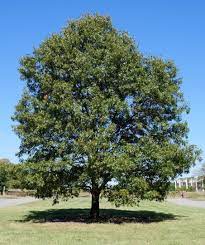
Scarlet Oak trees are a medium to large deciduous tree that belongs to the red oak family.
Scarlet Oaks grow to heights of 60 to 80 feet with a canopy spread of 40 to 50 feet and a nine-foot trunk diameter. These trees grow at a medium rate of 12″ to 24″ a year and have a life cycle of 80 to 180 years.
These trees produce glossy green leaves that grow 4″ to 7″ long with seven lobes, topped with three to seven bristled teeth. In the fall, these leaves deepen to a bright scarlet, which gives this tree its name.
They produce 2″ to 4″ long slender yellow-green catkins and reddish-green female flowers that form small spikes. The flowers are non-ornamental and unimpressive.
They grow ovate acorns ½” to 1″ in size, inside a scaly cup. These nuts start green before maturing to a pale brown or red when ripe, which takes 18 months after pollination.
Origins
Scarlet oak trees are native to the central and eastern US. They grow from the southern parts of Maine over to Missouri, Michigan, and Wisconsin. And they go as far south as Georgia, Louisiana, and Alabama.
#44. White Oak (Quercus alba)

White Oak trees are deciduous hardwood, also called stave oak. Despite the name, these trees do not appear white. The name refers to the inner wood’s color, which is heavily desired for furniture and barrels to make whiskey and wine.
White oak trees can grow up to 50 to 80 feet with a 50′ to 80-foot canopy spread. They have a two to three-foot diameter trunk with an average growth of 12″ to 24″ a year. They can live up to 200 or 300 years.
These trees have a light ashy-gray bark that peels from the top, sides, and bottom. Halfway up the tree, the bark will form overlapping scales and shallow fissures. Early tree branches start as bright green before darkening to a reddish-green and then light gray.
The young leaves start as a silvery pink with thick down in the spring. They turn yellow-green within a few days and grow up to 5″ to 9″ long. Mature leaves will have a dark green glossy top that turns red, purple, or brown in the fall.
Flowers bloom in May with male flowers growing in fuzzy 2 ½” to 3″ yellow aments. Female flowers form as hairy reddish peduncles. They begin to produce ½” to 1″ acorns at 50 years, with amounts varying for each crop. These fall from the trees in October.
Origins
White oaks are native to central and eastern North America. They grow as far north as Quebec, Ontario, Minnesota, and southern Maine and as far south as eastern Texas and northern Florida.
#45. Eastern White Pine (Pinus strobes)
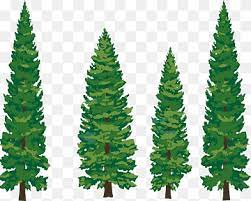
The Eastern White Pine – also called northern white pine, soft pine, Weymouth pine, and white pine – is one of over 100 Pine species. It is coniferous, meaning it does not change color or lose its leaves in the winter. It stays a consistent green color.
Eastern White Pines can live to be 200 years old, although some have survived up to 450 years. These trees grow to heights of 80 to 110 feet with a three to five-foot trunk width and a canopy spread of 20 to 40 feet. They have a fast growth rate of two to three feet a year.
These trees have 1″ to 2″ thick gray-brown bark with dark-tinted scaly plates and broad ridges. When young, the bark will be smooth and thin and may have a green hue.
They produce 2″ to 6″ slender and flexible, blue-green needles in bundles of three to five. These needles have fine serrations and three sides. An interesting fact is they only shed needles every one to four years.
These trees do not produce flowers but have small yellow cones (male) and 3″ to 8″ hanging female cones that take two to three years to mature and shed the seeds. White pines do not reach sexual maturity until 20 to 30 years and only reproduce once every three to five years.
Origins
Eastern white pine is a native plant of the eastern United States. It grows in Canada from Newfoundland, through the Great Lakes, and in southeastern Manitoba. In the US, it grows in Minnesota, throughout the Appalachian Mountains, and in some of northern Georgia.
Rare growth occurs at high elevations in northeast Alabama and classifies as a rare tree in Indiana. Seeds from this tree were exported to England in 1605. There, it is called the Weymouth pine.
#46. Pitch Pine (Pinus rigida)
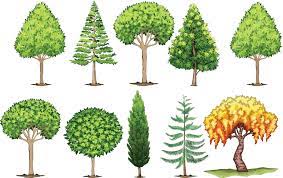
Pitch pines, also called torch pines, are a small to medium evergreen (coniferous) species of the pine family.
Pitch pines are not a long-lived tree. They have a lifespan of 12 to 170 years, with most not living over 100 years. And they grow up to 40 to 70 feet, rarely topping 82 feet.
They have a slow to medium growth rate of fewer than two feet a year with a round or irregular crown spread of 30 to 50 feet. Once these trees reach maturity height, growth will slow to less than one foot a year.
They have a straight or curved trunk with a diameter of 1 to 3 feet. The outer tree has thick light brown rough bark covered with irregular plates and deep fissures.
These trees do not produce leaves but instead have stiff straight, or slightly curved needles that form in bundles of three. These have serrated margins with a dark green color. Newer needle growths will have a yellow tint.
They also do not produce flowers but do develop male and female cones. Male cones grow at the base of the year’s new growth along lower branches. Female cones are found on the upper branches and can take two years to mature after pollination. These cones store the winged seeds.
Origins
These trees are native to the northeastern US with small subsets in southern Quebec and Ontario, Canada, along the St Lawrence River’s shoreline.
This pioneer species grows as far west as Kentucky, as far south as northern Georgia, and up to central Maine. This area includes eastern Tennessee, western South Carolina, Virginia, southeast New Jersey, Cape Cod, Long Island, Pennsylvania, and southern Ohio.
#47. Red Pine (Pinus resinosa)
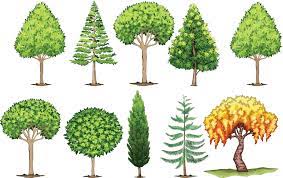
Red Pine, sometimes referred to as Norway pine,
Red Pines has a medium to fast growth rate of one to two feet a year with a height span of 66 to 115 feet. They form a conical or narrow round canopy with a spread of varying widths. These trees have a lifespan of 200 to 400 years.
These trees have a trunk diameter of three feet, covered by thick reddish-brown bark with flat, large plates that form a diamond pattern. Bark higher up near the crown gets thin, flaky, and has a bright reddish-orange color. There may also be red tints in the fissures. Young trees may have scaly orange-red bark.
Red pines produce dark yellowish-green needles that grow 4″ to 7″ long in pairs. These needles have serrated edges. These needles live up to five years before they fall off.
These trees start to produce reproductive seeds between 15 and 25 years old, with heavy production every three to seven years. The seeds come from the small 2″ to 3″ light brown cones, which grow alone or in pairs.
These cones may appear purple when first emerging. They darken to a nut-blue or dark brown and open when mature. The pine cones have a pointed tip on each scale.
Origins
Red Pine is native to North America. It grows from Manitoba to Newfoundland in Canada. You can find these trees as far south of Canada as Pennsylvania.
Small populations grow in West Virginia and Virginia in the Appalachian mountains. And a few remote areas exist in northern Illinois and northern New Jersey. This species covers more than 1.6 million acres throughout Michigan, making it the fourth most abundant tree.
#48. Scots Pine (Pinus sylvestris)
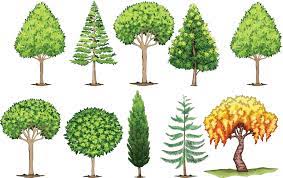
The Scots Pine – also called Scotch pine, Baltic pine, and European red pine – is the national tree of Scotland and a popular coniferous species for Christmas trees. It was once called the Scots fir.
Scots Pine trees can grow to heights of 60 to 125 feet with a crown spread of 40 feet. These trees have a slow to medium growth rate of 12″ to 24″ a year. They can live 150 to 300 years, although some of the oldest Scots trees lived to be 760 years old.
This tree grows a long straight trunk with a three-foot diameter, covered by dark scaly bark near the base that lightens to rust-colored towards the tree’s top.
These trees produce twisted pairs of 1″ to 3″ blue-green needles that can sometimes lighten to yellow-green during winter. The needles shed every three years. They form in an alternating spiral and have a wonderful aroma and sharp tips.
These trees form 1″ to 3″ oval cones with diamond scales. When young, these cones have a pink or red color that darkens to gray-brown once pollinated. They form pine nuts once they’ve reached maturity.
Origins
This pine species is a native of Eurasia. These trees grow from Western Europe into Eastern Siberia. To the south, they grow as far as Anatolia and the Caucasus Mountains. They even grow in Fennoscandia inside the Arctic Circle.
These trees can survive up to 3,300 feet above sea level and at altitudes of 3,9000 to 8,500 feet. They grow in Russia, all of Eastern Europe, and some states in the United States in zones 3-7. The species is declining due to Pine Wilt, a fatal disease.
#49. Eastern Red Cedar (Juniperus virginiana)
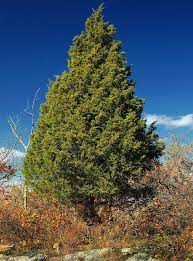

Eastern Red Cedar – also known as red cedar, eastern juniper, pencil cedar, red juniper, aromatic cedar, and Virginian juniper – is a coniferous juniper tree species.
Eastern Red Cedar trees can grow to heights of 16 to 66 feet with a canopy spread of 12 to 15 feet. These trees grow at a slow rate of 12″ to 18″ a year. They have a life expectancy of 150 years.
These trees’ trunk is less than three feet in diameter and covered with reddish-brown fibrous bark that you can peel off in strips.
These trees produce two different types of leaves. Young leaves appear on plants less than three years old and mature trees in shady spots. These are short (1/16″ to 3/16″) and sharp. Adult leaves overlap in patterns of two or four in whorls of three or decussate pairs.
All of the leaves will be light green, but older leaves have whitish-silver accents. When old, leaves will turn brown and fall off, which can take multiple seasons.
These trees can be dioecious or monoecious. They produce small male cones that are yellow-brown and form in groups. Female cones have a light greenish-blue color and contain one to three seeds. The seeds are ¼” wide and ⅙” long with a sharp tip and a blue wax coating.
Origins
The Eastern redcedar grows in every state east of the Great Plains, from Canada down to Florida and west to Texas. It’s native to Kansas and Virginia. It grows best in zones 2-9.
These trees are commonly spotted growing in low mountains. Many areas consider this species to be invasive, even in places where it grows native.
#50. Sassafras (Sassafras albidum)
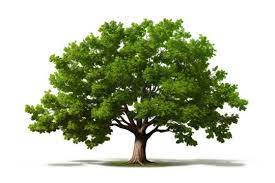
Sassafras, also called red, white, or silky sassafras, is a deciduous species with a strong history in Europe and North America for its various uses.
Sassafras trees grow at a medium/fast rate of 13″ to 24″ a year. They grow to heights of 49 to 66 feet tall with a spread of 39 feet and a trunk diameter of 24.”
These trees have thick, reddish-brown bark with deep furrows. The inner bark is red-orange, which you can see if you break off a piece of outer bark. Younger trees have smooth bark with a green tint.
Leaves on this tree grow alternate in an obovate or ovate shape to lengths of 4″ to 6″ and 2″ to 4″ widths. The leaves can grow in three distinct shapes, with all three types growing on the same limb. They can be three-lobed, two-lobed, or unlobed elliptical.
In spring, the leaves have a light green color, with some looking more yellow than green. In the fall, they change to yellow with red tints.
These trees produce flowers in the early spring before the leaves emerge. These yellow or green-yellow blooms can be 2″ in length.
Flowers with nine stamens means the tree is male. If there are six shortened stamens, it’s a female. You rarely see sassafras trees with both male and female flowers.
Sassafras trees also produce tiny bluish-black drupes, which contain a single seed. These grow on a red clubbed pedicel and ripe in the late summer.
Origins
Sassafras is native to eastern Asia and eastern North America. These trees grow from the southernmost areas of Ontario, Canada, throughout the eastern US, down to central Florida, west to East Texas, and southern Iowa.
These trees used to be abundant in southern Wisconsin but are now extirpated. They grow in many deciduous habits at altitudes below 5,000 feet above sea level.
#51. Shadbush (Amelanchier Canadensis)
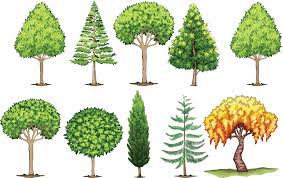
The Shadbush tree has many other names, including wild-plum, sugarplum, juneberry, saskatoon, shadwood, shadblow, sarvisberry, Sarvis, serviceberry, and chuckley pear. There are over 30 species that belong to this genus.
These are small deciduous trees that grow to low heights of 15 to 25 feet and belong to the Rose family. They have a slow growth rate of less than one foot a year and a short life span of fewer than 50 years.
These trees have round, long leaves with fine-toothed edges. They form an alternate pattern. In fall, these leaves turn from bright green to bright yellow, orange, and red.
Between March and May, these trees blossom with clusters of five-petaled white flowers. These will last less than a week before they form into ¼” to ½” round reddish-purple fruit that turns black once ripened between June and July.
Origins
The Shadbush is a native tree of eastern North America. It has the highest concentration of growth in southeastern Canada and the northeast US.
Every state in the US except Hawaii is the native ground of one or more of this genus species, including 20 different types. Two of these species are native to Asia and one to Europe.
#52. Red Spruce (Picea rubens)
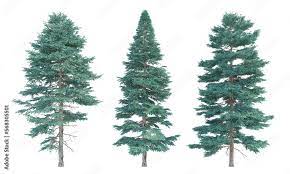
The Red Spruce, also called West Virginia spruce, yellow spruce, hebalsam, and eastern spruce, is a coniferous member of the spruce family.
These trees can grow from 59 to 131 feet tall with a 24-inch diameter trunk and a conical crown spread. They can live up to 400 years with a growth rate of fewer than two feet a year.
These trees’ outer bark is thin grayish-brown or reddish with scales; inner wood is red-brown with narrow rings.
These trees grow yellow-green needles less than an inch in length, with four curved sides and a sharp point.
In May, they produce bright red pendant male flowers and erect bright green female flowers with purple tints.
Origins
The Red Spruce tree is a native of eastern North America. It grows as far north in Canada as Nova Scotia and eastern Quebec.
It stretches throughout the Adirondack and Appalachian mountains, including New England, eastern Tennessee, eastern West Virginia, Pennsylvania, Massachusetts, New Jersey, and western North Carolina.
#53. White Spruce (Picea glauca)
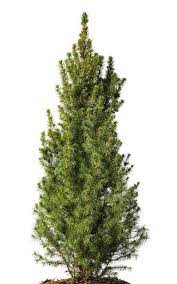
White Spruce is a member of the Pine family. It also goes by the name Canadian spruce, Porsild, western white spruce, Black Hills spruce, skunk spruce, cat spruce, and Alberta white spruce. This evergreen tree keeps color year-round.
White Spruce trees grow up to 40 to 60 feet tall with a 10 to 20-foot canopy spread. They have an average medium growth rate of 13″ to 24″ a year and a life expectancy of 100 to 250.
They have scaly bark that’s gray or silver and flakes off in 2″ to 4″ circles. Young trees have a conic spread, while older trees form a cylindrical shape.
They produce short diamond needles instead of leaves that have a blue-green top and a blue-whitish bottom.
These trees also produce 1 ¼” to 2 ¾” pendulous cones that are ⅝” wide when sealed and 1″ wide when opened. These appear red or green when young and darkening to pale brown between 4 and 8 months after being pollinated.
Origins
The white spruce is a native species to boreal forests in North America. These trees originally grew in Alaska and across Canada to Newfoundland and the Avalon Peninsula.
It grows throughout the northern border states of Minnesota, Michigan, Montana, Minnesota, New Hampshire, Vermont, and Maine. There are also isolated populations in Wyoming and South Dakota in the Black Hills.
#54. Sycamore (Platanus occidentalis)
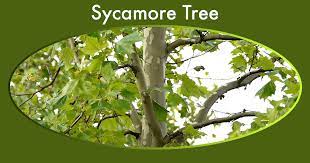
The Sycamore – also called the western plane, American planetree, water beech, buttonwood, and occidental plane -is the largest deciduous tree growing in the United States.
Sycamore trees can grow to heights of 70 to 100 feet with a spread of 65 to 80 feet with a moderate to fast rate of more than two feet each year. They have an impressive lifespan of 600 years.
These trees have an attractive looking dark red to brown bark with irregular mottled patches of brown, gray, yellow, and green-tinted white. The bark stretches, infills, and splits to accommodate the tree’s growth.
Many Sycamore trees have multiple secondary trunks. The way the limbs spread at the top forms an open, irregularly shaped crown.
They form alternate 4″ to 9″ leaves of various shapes with three to five lobes. These are pale green and covered with tomentum when first blooming. Mature leaves turn bright yellow on top with a pale bottom and brown in the fall.
They produce red male flowers and yellow female flowers that form into small brown burr fruit in May.
Origins
The Sycamore tree originated from the eastern and central United States, northeast Mexico, and Ontario’s extremely south areas. It might have originated in Ontario as well.
#55. Black Willow (Salix nigra)
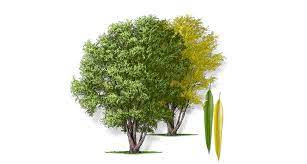
Black Willow trees are a member of the willow family. These trees grow to heights of 30 to 60 feet with a 20″ to 30″ diameter single trunk and a spread of 73.”
Black Willow trees have thick black to dark brown bark with deep furrows. Some trees will fork near the base.
The leaves are 2″ to 6″ long and ¼” to ¾” thin with a shiny green top and a soft green bottom. They have serrated edges and a short stem. Leaves turn to lemon yellow in fall.
They produce green or yellow catkins that contain a red-brown capsule (fruit) that holds the fuzzy seeds.
Origins
These trees originated in the eastern United States and do best in areas with an average rainfall of at least 51″ a year. They grow from southern Ontario to New Brunswick in Mexico.
In the US, they stretch from the east coast west to Minnesota and some of Utah. They also grow down into Florida and Texas. And some growths appear in Mexico, west, and south of the Rio Grande.
#56. Eucalyptus (Eucalyptus)
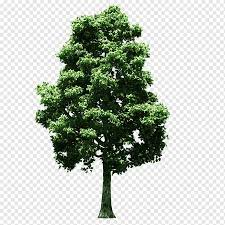
Eucalyptus is a genus-species that includes over 700 types of flowering trees and shrubs belonging to the myrtle family. They are often called stringybark or gum trees.
The Eucalyptus tree can grow from 33 feet to 200 feet, depending on the type.
These trees have a unique feature that allows them to grow new bark every year as the outer layer dies. The dead bark can peel in flakes, ribbons, or large pieces and go by smooth bark. Other species will retain the dead bark along the lower half or at the base. These are blackbutts.
Most eucalyptus trees are evergreen, but a few species will lose their leaves every season. These leaves have oil glands and an alternate pattern with a glossy or waxy green color.
And most species will produce distinctive flowers and fruit gumnuts. The flowers can be white, yellow, cream, red, or pink with no petals. The fruit forms a cone with valves on each end to release the waxy, 1mm long yellow-brown seeds.
Origins
Eucalyptus trees are natives of Australia, and other islands, including Tasmania. Over ¾ of the forests in Australia are eucalypts, and each territory and state has specific species.
Some species also grow in California, although they are not native to the area. They were imported in the 1850s.
#57. Dogwood (Cornus florida)
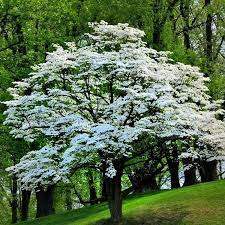
Flowering dogwood trees get their name from the attractive spring flowers. This tree is one of the most desired species in the southern US. Other names less frequently used include Indian arrowwood, white dogwood, white cornel, false boxwood, Florida dogwood, American dogwood, and Cornelian tree.
Dogwood trees can grow from 15 to 40 feet in height with a spread of 25 feet and a trunk diameter of 6″ to 12.” These trees grow at a rate of 13″ to 24″ a year. They have a lifespan of 80 years.
The leaves of flowering dogwood trees are opposite ovate with a 2″ to 5″ length and a very fine-toothed margin. The leaves are green in the spring and turn reddish-brown in the fall.
They produce white, pink, or yellow flowers in late winter to early spring before the leaves. These flowers form into scarlet red or pink drupe fruits in clusters of two to ten.
Origins
The flowering dogwood tree is native to northern Mexico (Veracruz) and eastern and southern states in North America.
These trees spanned from coastal Maine down to northern Florida and as far west as the Mississippi River.
Deciduous Trees vs. Coniferous Trees
We classify trees into two categories – deciduous and coniferous. When a tree falls into a category, it will share similar traits with other tree species of the same class.
Coniferous
Coniferous trees classify as evergreens. These trees keep their green color throughout the year. Unlike deciduous trees, the leaves of coniferous trees will not change colors or shed annually.
When Coniferous trees lose their leaves, it is a sign of an environmental issue. You may want to do some research to figure out the problem causing the stripped tree.
Deciduous
Deciduous refers to hardwood trees. This category of trees have leaves that change colors and shed annually or seasonally.
During the fall or when cold weather begins, the leaves will darken and fall off. The limbs will be bare during the winter. As spring rolls around, the trees will grow new leaves that will age and fall off at the end of the year.
How To Identify the Types of Tree Leaves
Many times, you can identify the type of tree by examining the leaves. Here are a few ways you can determine the kind of tree leaves.
First, determine if the leaf is a broadleaf, scale, or a needle. Most broadleaf trees are deciduous, while trees with needles and scales are more often coniferous.
The leaf’s shape can also help identify the type. The different shapes include:
- Cordate – heart-shaped
- Ovate – egg-shaped
- Orbicular – round
- Lanceolate – long, narrow
- Deltoid – triangular
- Lobed – usually oak
- Palm – usually maple
You can also look at the tree’s bark color. Some trees have specific colored bark such as birch, which has pure white bark, beech has silver, mulberry is cinnamon-colored, paperbark maple has a copper color, and aspens have greenish-white.
Conclusion
We hope we’ve helped you understand the different types of trees and how to tell these species apart. We’ve given you 57 common tree species and described their characteristics. We’ve also provided helpful pictures so you can be a tree identifier in no time.

